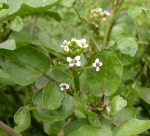 Also called yellowcress, this aquatic or semi-aquatic perennial is native to Europe and Asia where it grows in cold lakes and reservoirs, and along slow-moving streams and rivers. It is a member of the cabbage family, Brassicaceae, that also includes broccoli,mustard, and alyssum, but is not closely related to the annual flower commonly called nasturtium. The plants are fast growing reaching 4-20″ tall and have hollow branched stems that cause the plants to float. The pinnately compound leaves have 3-7 oval to egg-shaped leaflets up to 1/2″long. Terminal elongating racemes of small white flowers 1/4″ across appear from mid to late summer and are attractive to insects, especially hoverflies. Watercress is used in cooking for its peppery taste and is especially valued for salads. Plants can be very invasive. The genus name, Nasturtium, comes from the Latin words nasus meaning nose, and tortus meaning twisted, and refers to the pungent taste. The specific epithet, officinalis, is the Latin word meaning sold in shops and refers the medicinal value of the plant.
Also called yellowcress, this aquatic or semi-aquatic perennial is native to Europe and Asia where it grows in cold lakes and reservoirs, and along slow-moving streams and rivers. It is a member of the cabbage family, Brassicaceae, that also includes broccoli,mustard, and alyssum, but is not closely related to the annual flower commonly called nasturtium. The plants are fast growing reaching 4-20″ tall and have hollow branched stems that cause the plants to float. The pinnately compound leaves have 3-7 oval to egg-shaped leaflets up to 1/2″long. Terminal elongating racemes of small white flowers 1/4″ across appear from mid to late summer and are attractive to insects, especially hoverflies. Watercress is used in cooking for its peppery taste and is especially valued for salads. Plants can be very invasive. The genus name, Nasturtium, comes from the Latin words nasus meaning nose, and tortus meaning twisted, and refers to the pungent taste. The specific epithet, officinalis, is the Latin word meaning sold in shops and refers the medicinal value of the plant.
Type: Aquatic or semi-aquatic perennial
Bloom: Terminal clusters of small white flowers from mid to late summer
Size: 4-20″ H 39″ W
Light: Full sun to partial shade
Soil: Wet
Hardiness: Zones 3-11
Care: Remove before becoming invasive
Pests and Diseases: Cercospora leaf spot, Septoria leaf spot. black rot, damping off, crook root, watercress yellows, water snails, slugs, shrimps, springtails, thrips, aphids, caddis-fly larvae, diamond back moth, beetles, stink bugs, cyclamen mite, weevils, flies, wildfowl, deer and muskrat.
Propagation: Seed, division, cuttings
Companion Plants: Not applicable
Photo Credit:Wikipedia